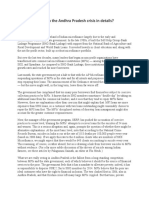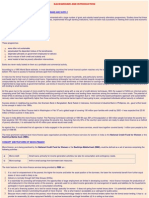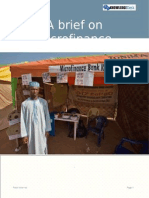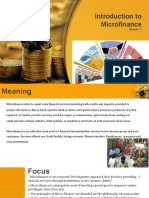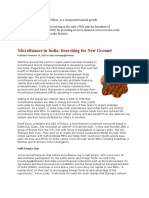Customer Satisfaction and Microfinance in Unacco
Customer Satisfaction and Microfinance in Unacco
Uploaded by
Omita ChanuCopyright:
Available Formats
Customer Satisfaction and Microfinance in Unacco
Customer Satisfaction and Microfinance in Unacco
Uploaded by
Omita ChanuCopyright
Available Formats
Share this document
Did you find this document useful?
Is this content inappropriate?
Copyright:
Available Formats
Customer Satisfaction and Microfinance in Unacco
Customer Satisfaction and Microfinance in Unacco
Uploaded by
Omita ChanuCopyright:
Available Formats
BY WAIKHOM BHOPENDRO SINGH MBA(3rd sem) Galaxy global Group Of Institutions, 22nd november 2012
What is Microfinance Role of microfinance Origin of microfinance Profile of Microfinance Institution in India and growth Activities in microfinance SHG and how it work Top five leaders &players in Microfinance industry as per crisil rating. Working process of microfinance industry in India. Company profile, vision and mission Findings from the study. Suggestions and conclusion.
According to International Labor Organization (ILO), Microfinance is an economic development approach that involves providing financial services through institutions to low income clients.
Microfinance helps poor households meet basic needs and protects them against risks. The use of financial services by low-income households leads to improvements in household economic welfare and enterprise stability and growth. By supporting womens economic participation, microfinance empowers women, thereby promoting gender-equity and improving household well being.
The emergence of informal financial institutions in Nigeria dates back to the 15th century, they were first established in Europe during the 18th century as a response to the enormous increase in poverty since the end of the extended European wars (1618 1648). In 1720 the first loan fund targeting poor people was founded in Ireland by the author Jonathan Swift. After a special law was passed in 1823, which allowed charity institutions to become formal financial intermediaries a loan fund board was established in 1836 and a big boom was initiated.
Their outreach peaked just before the government introduced a cap on interest rates in 1843. At this time, they provided financial services to almost 20% of Irish households. The credit cooperatives created in Germany in 1847 by Friedrich Wilhelm Raiffeisen served 1.4 million people by 1910. He stated that the main objectives of these cooperatives should be to control the use made of money for economic improvements, and to improve the moral and physical values of people and also, their will to act by themselves. In the 1880s the British controlled government of Madras in South India, tried to use the German experience to address poverty which resulted in more than nine million poor Indians belonging to credit cooperatives by 1946
. During this same time the Dutch colonial administrators constructed a cooperative rural banking system in Indonesia based on the Raiffeisen model which eventually became Bank Rakyat Indonesia (BRI), now known as the largest MFI in the world.
Microfinance began in India in the 1990s as a way of alleviating poverty, by encouraging income generating activities by poor households. Estimated that 350 million people live Below Poverty Line This translates to approximately 75 million houses. Annual credit demand by the poor in the country is estimated to be about Rs. 60,000 crores. Cumulative disbursements under all micro finance programmes is only about Rs. 5000 crores. Total outstanding of all micro finance initiatives in India estimated to be Rs. 1600 crores. Only about 5 % of rural poor have access to micro finance.
Some quick highlights industry growth in India: MFIs have recorded about 8.5 million clients during the year 2008-09, a growth of 60% over the previous year. More than 50 percent of low income households are covered by some form of microfinance product The total outstanding microfinance loans posted a growth rate of 30% or 359.39 billion over the last years level of Rs 229.54 billion. The overall coverage of the sector is estimated to have reached 76.6 million against 59 Million last year. The SHG loan outstanding has increased by Rs. 71.5 billion with an addition of 6.9 million clients.
Some parts in Karnataka faced entrenched default constituting a portfolio share of less than 0.5%. MFIs so far reached 234 of the 331 poorest districts identified by the government. SBLP registered a decline of number of women SHGs from 82.5% in March 2007 to 80.4% in March 2008. The microfinance penetration index shows especially in Bihar, Madhya Pradesh, Rajasthan and Uttar Pradesh compared to extraordinary levels reached in Andhra Parades, Karnataka and Tamil Nadu. While last years report focused on the increased risk in the sector, this years report takes stock of the uninterrupted growth rate of the sector despite several internal and external adversities.
Microcredit Micro savings Micro insurance Remittances
NABARD (1997) defines SHGs as "small, economically homogenous affinity groups of rural poor, voluntarily formed to save and mutually contribute to a common fund to be lent to its members as per the group members' decision". Most SHGs in India have 10 to 25 members, who can be either only men, or only women, or only youth, or a mix of these. As women's SHGs or sangha have been promoted by a wide range of government and nongovernmental agencies, they now make up 90% of all SHGs.
SKS Microfinance Ltd (SKSMPL) Spandana Sphoorty Financial Ltd (SSFL) Share Microfin Limited (SML) Asmitha Microfin Ltd (AML) Shri Kshetra Dharmasthala Rural Development Project (SKDRDP)
The company was launched as a non banking finance company in September 2008 under the name of Shavi Trexim and Holdings Pvt. Ltd. In the year 2009 considering the growth of the company the name was changed to UNACCO FINANCIAL SERVICES PVT. LTD. having it's Head Office at National Games Village Apartment, Flat No.402, 4th Floor, Block No. A15, Borsajai, National Highway 37, Beltola, Guwahati- 781029. The Registered Office of the company is at 12/2, Sovram Bysak Street, Kolkata 700007
VISION:
1 million members in 2015.
MISSION:
To restore the pride through economic development and create sustainable social development Therefore, UFSPLs mission is to provide micro credit and other financial services to poor household by using women as medium To generate direct as well as indirect employment for educated un-employed local youths; To provide quality education at affordable cost to children of poor family; To improve the pace and quality of life of the rural and urban poor especially the village and decentralized sector
It is found that most the clients of the UNACCO come to know about the product and services through Field Executive and only a few members come to know through clients,advertisement,friends,relatives etc. It is also found that 20% of the current clients want to take individual loan for their business needs. It is also found that most of the clients of UNACCO are satisfied with the current interest rate only few clients are not satisfied. It is also found that the current clients are not taking loan from other sources other than UNACCO as they are satisfied with the UNACCOs services and only few are taking loan from other sources.
Some of the competitors of UNACCO are Loyalam,Chanura,YVU in manipur and Assomi,RGVN,Nghtingle..etc. in assam. Among these UNACCO is the leading company in providing loan facilities in manipur. The quality of the service experienced by the customers,the customer training provided by the company and field executive experience is found to be satisfactory and cooperative. There is no dissatisfaction in the loan collection procedure by the customers.
It is lkely to increase UNACCOs loan amount on the next term as 90% of the group member want to increase their loan amount in the next term as the current loan amount is not sufficient for their business. 20% of the group members want to take loan individually with higher loan amount.So it is also likely to give loan for individual as well as group. 20% of them want to change their payable day into monthly instead of paying monthly and 10% of them want to add some interest on their saving a/c.Some more suggestios are: The members are liked to decrease their deposit amount. It is also like to reach the advantages of UNACCO FINANCAL SERVICES LIMITED loan facility not only to some districts but also throught the manipur for a better socio-economic condition.
From the above it is felt that, Poor people need a variety of financial services, not just loans. It is a powerful tool to fight poverty further, Interest rate ceilings making it harder for poor people to get credit. The role of government is to enable financial services, not to provide them. Donor funds should complement private capital, not compete with it. The key bottleneck is the shortage of strong institutions and managers. In such a condition, UNACCO FINANCAL SERVICES LIMITED is helping Manipur to develop not only the organization but also to any field.
You might also like
- 7 Jamaica End of Year Examination.Document6 pages7 Jamaica End of Year Examination.Odayne Marshall100% (4)
- Micro Finance (BankingDocument35 pagesMicro Finance (BankingAsim Waghu100% (1)
- Discipline and Ideas in The Social SciencesDocument26 pagesDiscipline and Ideas in The Social SciencesJui Aquino Provido100% (16)
- Mfi Obj.1Document13 pagesMfi Obj.1Anjum MehtabNo ratings yet
- The Role of Micro Finance in SHGDocument12 pagesThe Role of Micro Finance in SHGijgarph100% (1)
- Anagha Suresh Project ReportDocument56 pagesAnagha Suresh Project Reportsouvikm056No ratings yet
- MICROFINANCEDocument62 pagesMICROFINANCEHarshal SonalNo ratings yet
- Status of Microfinance and Its Delivery Models in IndiaDocument13 pagesStatus of Microfinance and Its Delivery Models in IndiaSiva Sankari100% (1)
- Anagha Suresh (20YUCMD012) Project ReportDocument57 pagesAnagha Suresh (20YUCMD012) Project Reportsouvikm056No ratings yet
- Micro Finance AssignmentDocument8 pagesMicro Finance Assignment19DM017 .SubhamNo ratings yet
- Microfinance in India - A Tool For Poverty ReductionDocument20 pagesMicrofinance in India - A Tool For Poverty ReductionVijay KumarNo ratings yet
- The Microfinance Industry in IndiaDocument3 pagesThe Microfinance Industry in IndiaPrashant Upashi SonuNo ratings yet
- AJAD 2006 3 1 2 2thapaDocument22 pagesAJAD 2006 3 1 2 2thapaNishit RelanNo ratings yet
- JPSP 2022 203Document11 pagesJPSP 2022 203Anurag ShuklaNo ratings yet
- Microfinance Research PaperfinalDocument9 pagesMicrofinance Research PaperfinalChauhan NeelamNo ratings yet
- Micro Finance Need of The HourDocument11 pagesMicro Finance Need of The HouramarsxcranNo ratings yet
- Microfinance Report in MaharashtraDocument96 pagesMicrofinance Report in MaharashtraJugal Taneja100% (1)
- Topic of The Week For Discussion: 12 To 18 March: Topic: Microfinance Sector in IndiaDocument2 pagesTopic of The Week For Discussion: 12 To 18 March: Topic: Microfinance Sector in Indiarockstar104No ratings yet
- Emergence of Mfis and The Growth of Microfinance Sector in India ODocument5 pagesEmergence of Mfis and The Growth of Microfinance Sector in India OSiva KumarNo ratings yet
- Need For MF Gap DD and SSDocument2 pagesNeed For MF Gap DD and SSalviarpitaNo ratings yet
- Micro Finance in IndiaDocument59 pagesMicro Finance in IndiaApurva Bangera100% (1)
- Islamic Micro FinanceDocument6 pagesIslamic Micro FinanceMuhammed K PalathNo ratings yet
- Micro Finance AssignmentDocument4 pagesMicro Finance AssignmentLimasenla Moa100% (1)
- Amity UniversityDocument7 pagesAmity Universityrsrpk27No ratings yet
- Growth of Micro Finance in India: A Descriptive StudyDocument12 pagesGrowth of Micro Finance in India: A Descriptive StudyAkhil Naik BanothNo ratings yet
- Growth of Micro Finance in India A Descriptive StudyDocument12 pagesGrowth of Micro Finance in India A Descriptive StudyBobby ShrivastavaNo ratings yet
- A Brief On Microfinance: Patni InternalDocument4 pagesA Brief On Microfinance: Patni InternalshiprathereNo ratings yet
- Research Paper Suhail Khakil 2010Document13 pagesResearch Paper Suhail Khakil 2010Khaki AudilNo ratings yet
- Script 1Document19 pagesScript 1Manasi PatilNo ratings yet
- First and ForemostDocument7 pagesFirst and ForemostZakeyo Dala ChabingaNo ratings yet
- Microfinance in India: A Critique by Rajarshi GhoshDocument9 pagesMicrofinance in India: A Critique by Rajarshi Ghoshpraveen_jha_9No ratings yet
- Microfinace Reading PDFDocument9 pagesMicrofinace Reading PDFCharles GarrettNo ratings yet
- Micro Finance - Keys & Challenges:-A Review Mohit RewariDocument13 pagesMicro Finance - Keys & Challenges:-A Review Mohit Rewarisonia khuranaNo ratings yet
- Project On Micro FinanceDocument44 pagesProject On Micro Financeredrose_luv23o.in@yahoo.co.in88% (8)
- Presentation 1Document14 pagesPresentation 1faisalNo ratings yet
- Role of Micro Finance As An Anti Poverty Vaccine For Rural IndiaDocument7 pagesRole of Micro Finance As An Anti Poverty Vaccine For Rural IndiaSajijul IslamNo ratings yet
- A Presentation On Micro Finance 1Document22 pagesA Presentation On Micro Finance 1cynorayNo ratings yet
- Micro Finance and NGO'sDocument50 pagesMicro Finance and NGO'sMunish Dogra100% (2)
- 1 CF 3Document6 pages1 CF 3raghav.samaniNo ratings yet
- Chapter 4 Rural Banking and Micro Financing 1Document16 pagesChapter 4 Rural Banking and Micro Financing 1saloni100% (1)
- Report On Micro FinanceDocument54 pagesReport On Micro Financemohsinmalik07100% (1)
- SMART PUSHNOTE - An Agent Based Intelligent Push Notification System 2017-18Document60 pagesSMART PUSHNOTE - An Agent Based Intelligent Push Notification System 2017-18sachin mohanNo ratings yet
- Microfinance in India - Growth and Present StatusDocument16 pagesMicrofinance in India - Growth and Present StatusIJOPAAR JOURNALNo ratings yet
- Self Help Groups in India - A Study On Kavach SHG: by Abhishek KarishiddimathDocument10 pagesSelf Help Groups in India - A Study On Kavach SHG: by Abhishek KarishiddimathRahul SinghNo ratings yet
- Term Paper of Banking & Insurance: Topic: Micro Finance Development Overview and ChallengesDocument18 pagesTerm Paper of Banking & Insurance: Topic: Micro Finance Development Overview and ChallengesSumit SinghNo ratings yet
- 7.P Syamala DeviDocument4 pages7.P Syamala DeviSachin SahooNo ratings yet
- Thesis ProposalDocument30 pagesThesis ProposalmlachuNo ratings yet
- Role of Microfinance in Financial Inclusion in Bihar-A Case StudyDocument10 pagesRole of Microfinance in Financial Inclusion in Bihar-A Case Studyfida mohammadNo ratings yet
- Role of Microfinance Institution in Financial InclusionDocument15 pagesRole of Microfinance Institution in Financial Inclusionswati_agarwal67No ratings yet
- Microfinance Chapter 1Document27 pagesMicrofinance Chapter 1Prakash KumarNo ratings yet
- ATULDocument28 pagesATULRatul ChandelNo ratings yet
- Self Help GroupsDocument12 pagesSelf Help GroupsunknownNo ratings yet
- MICROFINANCINGDocument14 pagesMICROFINANCINGdippydadraoNo ratings yet
- Micro FinanceDocument42 pagesMicro Financebaap21No ratings yet
- Current Market Size of Rs27 BillionDocument5 pagesCurrent Market Size of Rs27 BillionSiddhartha BothraNo ratings yet
- Microfinance Capstone Mijjin OommenDocument4 pagesMicrofinance Capstone Mijjin OommenmijjinNo ratings yet
- Microfinance in India Scopes and LimitationsDocument41 pagesMicrofinance in India Scopes and Limitationsspy67% (3)
- Micro Finance Research Paper....Document25 pagesMicro Finance Research Paper....shaurya pratapNo ratings yet
- Micro CreditDocument9 pagesMicro Creditpalash dashNo ratings yet
- Access to Finance: Microfinance Innovations in the People's Republic of ChinaFrom EverandAccess to Finance: Microfinance Innovations in the People's Republic of ChinaNo ratings yet
- 2009 - Banca Mondiala - Analize Si Recomandari StrategiceDocument92 pages2009 - Banca Mondiala - Analize Si Recomandari StrategiceBalaniscu BogdanNo ratings yet
- Ascent of Women by Sally ArmstrongDocument23 pagesAscent of Women by Sally ArmstrongRandom House of CanadaNo ratings yet
- EDocument375 pagesEANA MARIA CRISTIANANo ratings yet
- Poverty in SULUDocument10 pagesPoverty in SULUmedzabubakarNo ratings yet
- Note: This Paper Contains Fifty (50) Multiple-Choice Questions, Each Question Carrying Two (2) Marks. Attempt All of ThemDocument12 pagesNote: This Paper Contains Fifty (50) Multiple-Choice Questions, Each Question Carrying Two (2) Marks. Attempt All of Themecobalas7No ratings yet
- Child Marriage in IndiaDocument13 pagesChild Marriage in IndiaArjinder SinghNo ratings yet
- Pantawid Pamilyang Pilipino ProgramDocument3 pagesPantawid Pamilyang Pilipino ProgramGercel Therese SerafinoNo ratings yet
- MSC Development Planning and Administration at The Development Planning Unit. University College LondonDocument2 pagesMSC Development Planning and Administration at The Development Planning Unit. University College LondonThe Bartlett Development Planning Unit - UCL0% (1)
- Article On India of My Dreams - APDocument4 pagesArticle On India of My Dreams - APSkillzy SupportNo ratings yet
- Satyaniketan-An NGO Working in The Tribal Areas of Maharashtra, IndiaDocument4 pagesSatyaniketan-An NGO Working in The Tribal Areas of Maharashtra, IndiamuthepNo ratings yet
- Rico Gear - Where It All BeganDocument2 pagesRico Gear - Where It All BeganalexanderbisleyNo ratings yet
- Drama-House of Bernarda Alba ReviewDocument88 pagesDrama-House of Bernarda Alba ReviewRohana FernandoNo ratings yet
- 25 Siliguri Draft ReportDocument72 pages25 Siliguri Draft Reportrahulchow2No ratings yet
- Income Inequality in BangladeshDocument15 pagesIncome Inequality in Bangladeshফারুক হোসেন রিমন0% (1)
- Niramaya Scheme - Health Insurance SchemeDocument21 pagesNiramaya Scheme - Health Insurance SchemeJaswanth Singh RajpurohitNo ratings yet
- Journey of Resilience: Overcoming Poverty Through Education in Dangcagan National High SchoolDocument11 pagesJourney of Resilience: Overcoming Poverty Through Education in Dangcagan National High Schoolkjarnado31No ratings yet
- Card MriDocument22 pagesCard MritanudyNo ratings yet
- S1 2015 320014 BibliographyDocument3 pagesS1 2015 320014 BibliographyaufiNo ratings yet
- Kisumu ISUD - Rapport PopulaireDocument18 pagesKisumu ISUD - Rapport PopulairewimeisingNo ratings yet
- Indigenous Income Support PDFDocument170 pagesIndigenous Income Support PDFainad1219No ratings yet
- Dwcra-A Successful Experiment To Emancipate Rural Women in ADocument15 pagesDwcra-A Successful Experiment To Emancipate Rural Women in AVinod KumarNo ratings yet
- Trysem ..Document27 pagesTrysem ..bukharisehar44No ratings yet
- Untitled PresentationDocument24 pagesUntitled Presentationapi-306431394No ratings yet
- Week 3 5 Module EAPP Reading Materials PETA 2 3 WW 2 3 and 1st Quarter AssessmentDocument28 pagesWeek 3 5 Module EAPP Reading Materials PETA 2 3 WW 2 3 and 1st Quarter AssessmentLuna CuteNo ratings yet
- 2281 Nos SW 5Document3 pages2281 Nos SW 5mstudy123456No ratings yet
- 5th Five Year PlanDocument13 pages5th Five Year Planmaverick2653100% (1)
- ESSAY by Mureed Hussain Jasra-1Document221 pagesESSAY by Mureed Hussain Jasra-1MuhammadNo ratings yet
- Poverty EssayDocument6 pagesPoverty EssayChloe AnnaNo ratings yet









